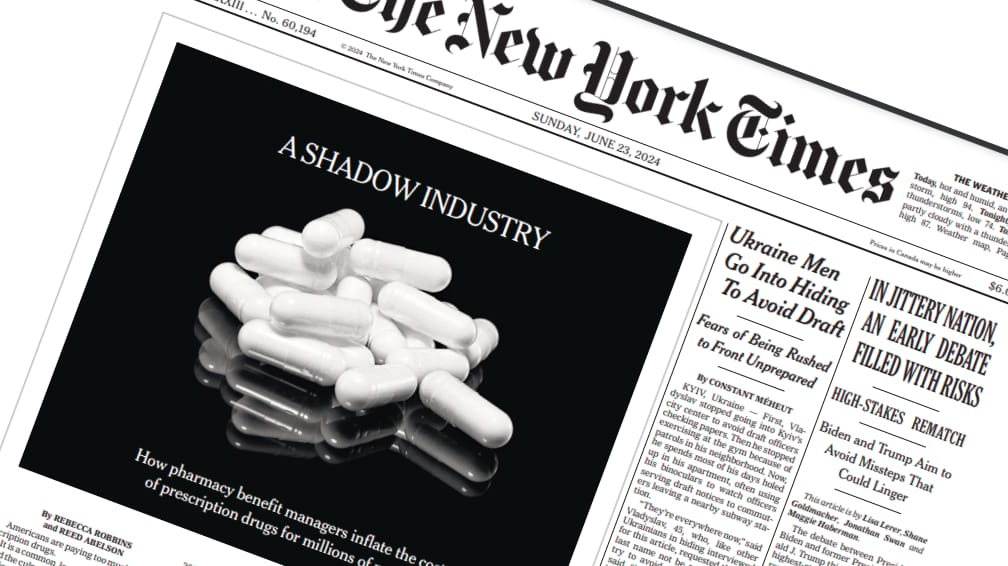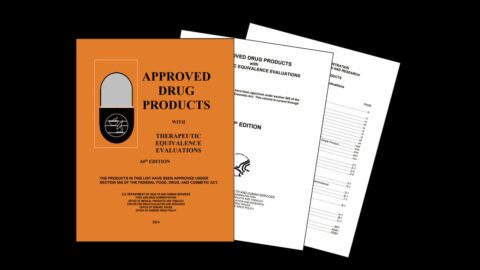If you want to search Cost Curve back issues or link to anything you read here, the web links and archive are online at costcurve.beehiiv.com. You can subscribe there, too.
I’m going to assume that you all have seen the New York Times piece on PBMs. It was all over social on Friday, and the paper gave a quarter of its front page to the story yesterday. News junkies know that when a paper runs a feature on A1 on a Sunday, it’s supposed to be an impact piece.
And it was.
Even if you’re jaded and found nothing new in the piece, it was an elegant piece of explanatory journalism. We’ll be talking about this one for a while.
But since you’ve already read it, I don’t want to spend any time summarizing it here.
Instead, I’ve been fascinated by the reaction, particularly from the PBMs. Because that response has been illuminating about whether PBMs are truly ready for what’s coming next in terms of both journalism and public policy.
There are three specific responses that caught my eye.
The first, and most general, was from AHIP. What fascinated me about that response was that AHIP didn’t even have the courage to call out the New York Times by name or bother working to refute any specific points. Instead, it was a list of supposed bad behavior by pharmaceutical companies.
But it was even weaker than that: AHIP didn’t mention “pharmacy benefit managers” or “PBMs” in its “Fact Check,” either. Even though the piece was clearly designed to defend PBMs, explicitly linking AHIP to PBMs is apparently a risk that even AHIP doesn’t want to take.
The second was the PCMA response, which had no problem calling out the NYT as “biased” and “incomplete.” But it was PCMA that ended up sounding incomplete, with the statement mostly pointing the finger for high drug prices at pharmaceutical companies.
I’d be a hypocrite if I suggested that there’s never a time for diversion and deflection. This is health care, after all. There is always someone else that can be blamed. The problem with the PCMA release was that it wasn’t responsive to the majority of the NYT piece, which raised concerns about everything from the role of GPOs to the treatment of pharmacies to the Cordavis/Quallent/Nuvaila gambit.
Instead, PCMA was taking whacks at a strawman. That suggests that the industry is not prepared to defend some of its business practices on the merits. Which means that additional stories in the NYT series could hit hard.
Finally, there was this LinkedIn post by David Joyner, the president of CVS Caremark. While I give Joyner a lot of credit for stepping up to push back, there were some eyebrow-raising bits of his clapback.
He started by suggesting that concerns about PBMs have been with us since time immemorial, flagging an NYT piece from 2003 that raised flags about turn-of-the-millennium PBM abuses. Why that should make us feel better about alleged abuses in 2024 is not clear to me.
I was also fascinated that Joyner decided to talk about what a good deal his company was delivering on insulin, bragging that his company is providing insulin at $25. This is a great applause line, but Lilly said last month that the net price — the price that PBMs pay — for its Humalog insulin was $26. The generic version Lilly makes is $17.
So CVS Caremark isn’t being particularly magnanimous in delivering insulin for $25.
None of this is to say that PBMs are not contributing anything to the health care system or that there aren’t other nooks and crannies worth exploring. (Trust me, the NYT hasn’t been shy about going after pharma.) Only that these particular responses don’t seem to be well-targeted to the critique that the Times is leveling … and will continue to level.
And that’s going to make the next few installments of the NYT series must-read journalism.
At some point, you will find me in an empty room at the Overlook Hotel, typing, “Drug prices are not skyrocketing, they’re falling. Drug prices are not skyrocketing, they’re falling. Drug prices are not skyrocketing, they’re falling …” over and over on a typewriter.
It’s not because I’m a modern-day Jack Torrance. It’s just that the evidence keeps pointing in that direction, yet no one seems to be noticing.
Anyway, SSR Health is out with their first-quarter numbers, which found that net prices fell again, as they have every quarter since 2018. The 1Q findings are linked to falling list price growth and Humira biosimilars.
The most noteworthy part of the oral arguments in the Boehringer Ingelheim case — which seemed to have the same level of judicial skepticism we’ve seen in other suits — may have been how little attention there was. Bloomberg Law has coverage, but that’s about it.
I’m fascinated by this STAT story, which says that the House Ways and Means Committee is soon to vote on a bill that allows for Medicare coverage of obesity meds, but in a “scaled back” form that won’t alarm budget hawks. I’m not quite sure how that mathematical magic trick works (and STAT isn’t sure, either), so this is one to watch.
BIO.news has a worthwhile look at what it means to be a unique drug from a regulatory standpoint. Under the FDA, the same chemical compound can be two medicines, each with its own individual name, new drug application … and a full set of expensive clinical trials and regulatory review. CMS, for the purposes of the IRA, throws all of that out, which is going to remove incentives for companies to do the kind of exhaustive, high-quality work that leads to new uses for older compounds.
This is a thoughtful AP story that wrestles with a really uncomfortable question: at what point is a disease so rare that a cure is not viable, economically?
Trikafta is going to be available to NHS patients in England, ending a protracted standoff over the price of the medicine.
The WSJ has the goods on a new NBER working paper that connects increases in hospital prices with job losses. The logic here is that health care costs are borne by employers, so anything that raises costs for employers will constrain employment. It feels like there is a reckoning coming for hospitals.
I’m almost as sick of Bernie Sanders as I am about writing about falling drug prices, but this NBC piece on Bernie’s obesity-drug media blitz is worth reading for one reason: NBC sticks a pin in the Bernie balloon. “In reality, there’s little Congress can do about the high cost of the weight loss drugs in the U.S. Novo Nordisk charging higher prices is partly a function of how the American patent system works,” NBC said. In other words, it’s the system, stupid.
Thanks for reading this far. I’m always flattered when folks share all or part of Cost Curve. All I ask is for a mention or tag. Bonus points if you can direct someone to the subscription page.





